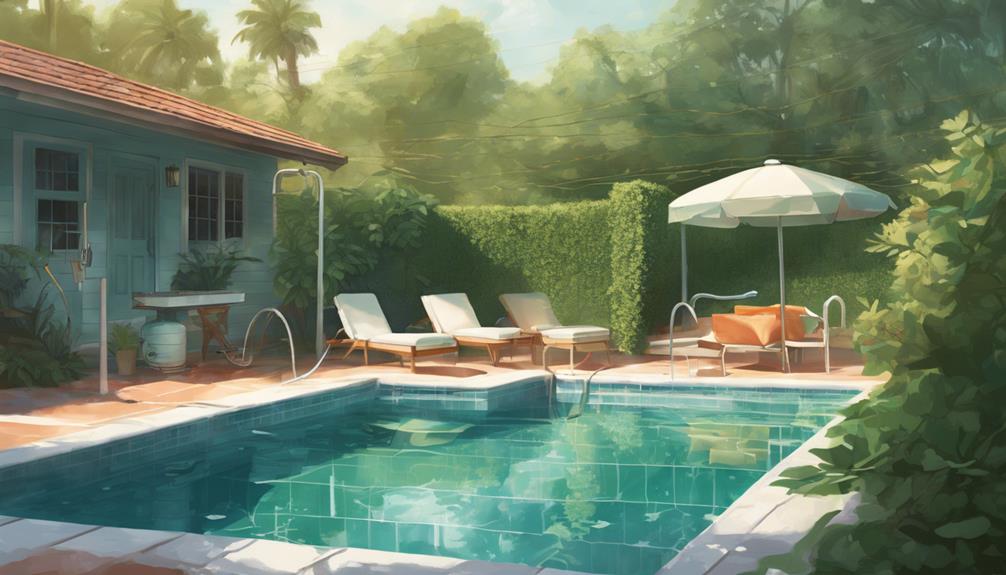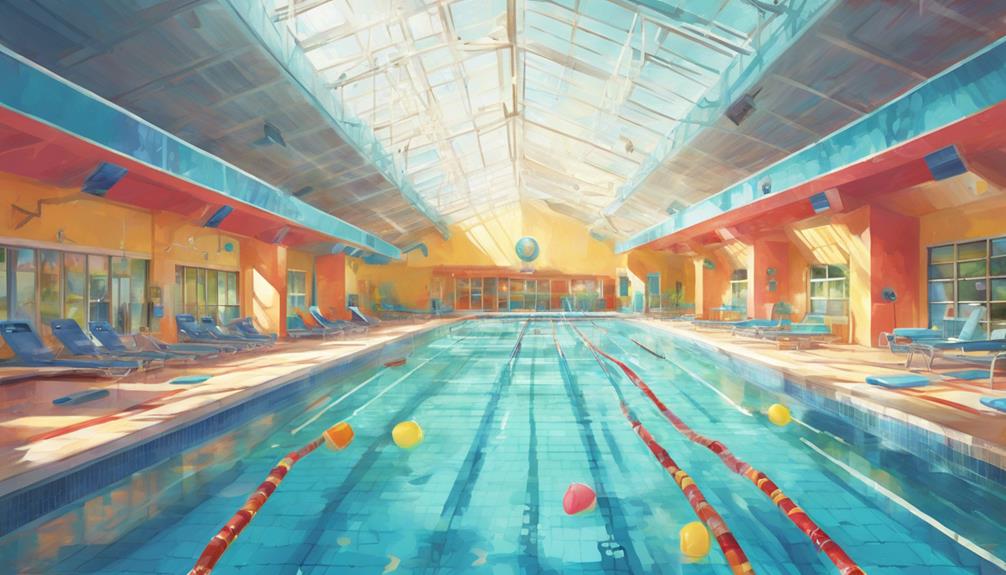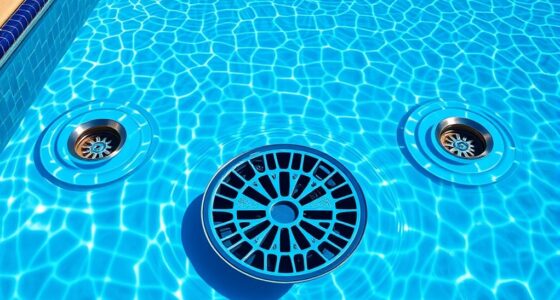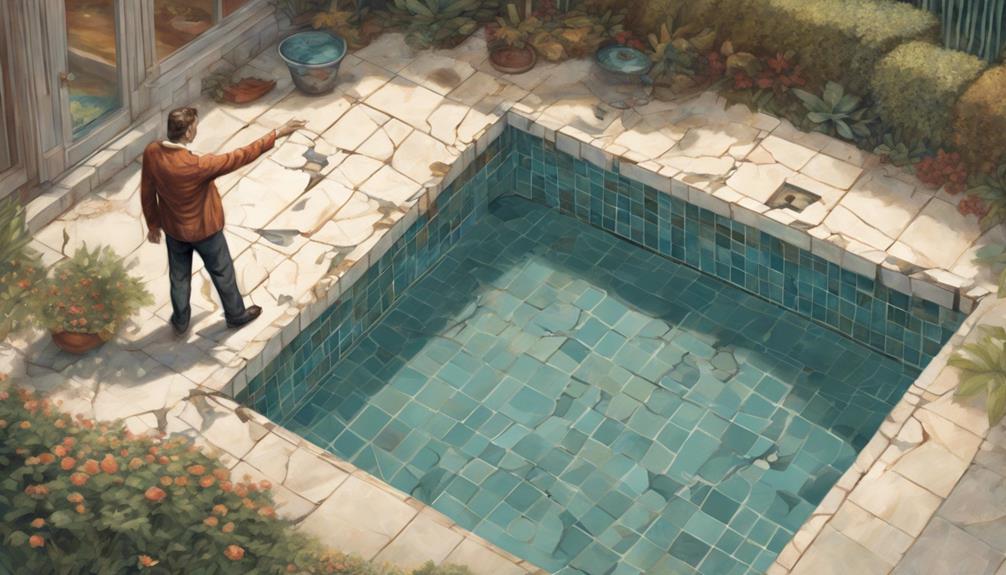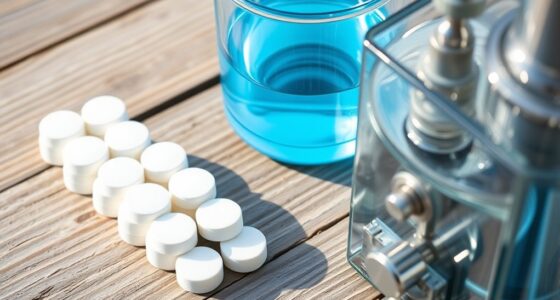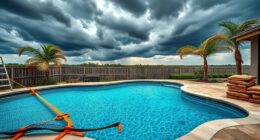For a pool that is ready for summer and shines effortlessly, focus on water level, pH, and chlorine levels. Maintain the water level at the mid-skimmer point to improve pump efficiency and chemical balance. Keep the pH levels between 7.2 and 7.8 to avoid skin irritation, easily checked with a pH kit. Monitor chlorine levels between 1-3 ppm for proper sanitation, preventing algae growth and skin issues. Regular checks using affordable kits help sustain excellent pool conditions. By mastering these fundamentals, you can ensure a pristine pool all season long. Learn these tasks to have a stress-free pool experience this summer.
Key Takeaways
- Maintain water level at mid-skimmer for efficient filtration and pump operation.
- Test and balance pH levels between 7.2-7.8 to prevent skin irritation and ensure water quality.
- Monitor and adjust chlorine levels (1-3 ppm) for proper sanitation and algae prevention.
- Keep pool water crystal clear by cleaning filters, skimming debris, and vacuuming regularly.
- Inspect and maintain pool equipment, including pump, heater, and cover, for optimal function.
Pool Water Level Maintenance
Consistently monitoring and maintaining the water level of your pool at the mid-skimmer level is essential for preserving pump efficiency, chemical balance, and overall pool performance during the summer months. Keeping the water level at the mid-skimmer point helps prevent pump damage and inefficiency, ensuring that the filtration system operates at its best.
Additionally, maintaining the water level at this point helps prevent chemical imbalances that can arise from an inadequate amount of water in the pool, avoiding issues such as algae growth or skin irritation. By adhering to the recommended water level, you not only enhance the pool's performance but also provide a pleasant and safe swimming environment for all users.
Prioritizing this aspect of pool maintenance is fundamental to enjoying a trouble-free swimming season.
Ph Level Testing
Maintaining the pH level within the recommended range is vital for ensuring proper pool water chemistry and a safe swimming environment. A pH level between 7.2 and 7.8 is best to prevent skin irritation from acidic water and skin problems from high pH. Regular testing using a pH monitoring kit is essential to maintain balanced pool water chemistry. Here is a quick reference guide for pH levels:
| pH Level | Effects |
|---|---|
| Below 7.2 | Acidic water, skin irritation |
| 7.2 – 7.8 | Best range |
| Above 7.8 | High pH, skin problems |
Chlorine Level Management
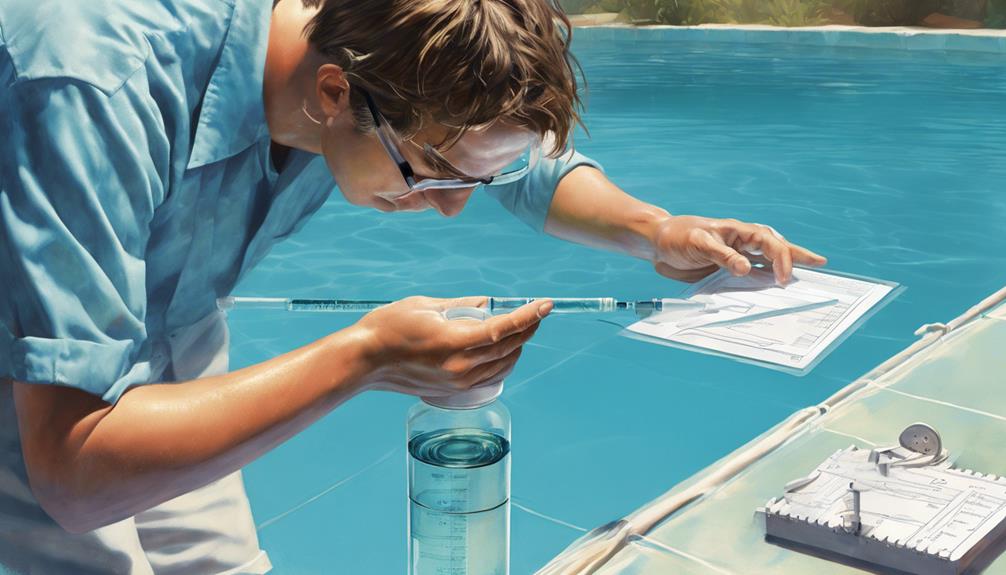
An important aspect of pool maintenance involves monitoring and adjusting the chlorine levels to guarantee proper sanitation and prevent algae growth.
Maintaining a chlorine level between 1-3 parts per million (ppm) is essential for effective pool sanitation. Adequate chlorine levels help prevent the growth of algae and bacteria, ensuring a clean and safe swimming environment.
Regularly testing the chlorine levels using affordable test kits allows pool owners to address any fluctuations promptly. By keeping the chlorine within the recommended range, pool owners can also prevent skin and eye irritation that can occur with over-chlorinated water.
Proper chlorine level management is key to enjoying a well-maintained pool throughout the summer season.
Frequently Asked Questions
How Often Should I Shock My Pool During the Summer?
During the summer, shock your pool every 1-2 weeks to maintain water clarity, eliminate impurities, and ensure effective sanitation. Regular shocking helps prevent algae growth, bacteria buildup, and creates a clean, safe swimming environment for best pool enjoyment.
Can I Use Regular Household Bleach to Increase Chlorine Levels?
Household bleach can be used to increase chlorine levels in pools. It contains sodium hypochlorite, similar to pool chlorine. However, make sure it's unscented and doesn't have additives. Use a pool calculator for proper dosing.
Is It Necessary to Adjust Pool Chemicals After Heavy Rain?
After heavy rain, adjusting pool chemicals is necessary to restore water balance. Rain can dilute chlorine levels and alter pH, affecting water quality. Regular testing and adjustment post-rain guarantee ideal chemical levels, preventing algae growth and maintaining a safe swimming environment.
What Is the Best Time of Day to Test Pool Water for Accuracy?
To guarantee accurate pool water testing, it is recommended to test the water during the early morning hours before any swimmers have entered the pool or any chemicals have been added. This provides a baseline reading for precise chemical adjustments.
Can I Swim Immediately After Shocking the Pool?
Swimming immediately after shocking the pool is not recommended. It is advisable to wait until the chlorine levels return to normal, typically within 24 hours. This guarantees the safety of swimmers by preventing skin and eye irritation.
What Pool Upkeep Tips Can Enhance the Ultimate Pool Party Experience?
When planning the ultimate pool party, it’s essential to consider some key pool upkeep tips to enhance the experience. Regularly checking chemical levels, skimming the surface for debris, and maintaining the filtration system are all ultimate pool party essentials to ensure a clean and inviting pool for your guests.
What Pool Upkeep Tips Can Enhance the Latest Pool Trends?
Looking to keep up with the hottest pool trends 2018? Regular maintenance is key. Keep your pool sparkling and inviting by investing in a robotic pool cleaner to save time and energy. Consider adding LED lighting for a modern touch, and don’t forget to stay on top of chemical balance for a safe and enjoyable swim.
What Quick and Easy Methods Can I Use to Remove Pool Stains?
There are several quick and easy methods for pool stain removal revealed. Using a stain removal product specifically designed for pools can effectively eliminate stains. Another method is to use a pool brush and a mixture of water and acid to scrub away the stains.
Conclusion
To sum up, a well-kept pool is a sight to behold during the summer months.
By staying on top of water levels, pH testing, and chlorine management, pool owners can guarantee a safe and enjoyable swimming experience for all.
Remember, 'a stitch in time saves nine' – taking small, proactive steps now can prevent larger issues down the road and keep your pool in pristine condition all season long.

